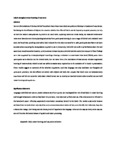Labels strengthen motor learning of new tools
| dc.contributor.author | Foerster, FR | |
| dc.contributor.author | Borghi, AM | |
| dc.contributor.author | Goslin, Jeremy | |
| dc.date.accessioned | 2020-04-27T13:43:18Z | |
| dc.date.available | 2020-04-27T13:43:18Z | |
| dc.date.issued | 2020-04-24 | |
| dc.identifier.issn | 0010-9452 | |
| dc.identifier.issn | 1973-8102 | |
| dc.identifier.uri | http://hdl.handle.net/10026.1/15601 | |
| dc.description | 12 months embargo applied | |
| dc.description.abstract |
Recent reformulations of the Sapir-Whorf hypothesis have shown how labels can guide our thinking in situations of uncertainty, facilitating the identification of objects. We examine whether the effect of labels extends beyond perceptual processes, to help us learn the motoric manipulations required to use novel tools. Exploiting immersive virtual reality, we measured behavioural movement latencies and electrophysiological activity from participants learning to use a range of labeled and unlabeled novel tools. We found that providing a tool with a label reduced the time taken to reach for it, with participants also faster and more accurate when executing the manipulations required to use it. Conversely, labels did not confer any facilitation when the tool was simply moved to another location; participants were slower to grasp a labeled tool when asked to transport it. These findings were also supported by electrophysiological recordings, showing a reduction in sensorimotor beta-band (~30 Hz) power when participants were asked to use the labeled tools, but not move them. This modulation of beta activity indicates augmented learning of motor-activity related to tool use within somatosensory regions due to the activation of its lexical representation. These results suggest an extension of the Whorfian hypothesis, such that language not only modulates our thoughts and perceptual processes, but also affects our actions with objects and tools. We propose that labels tune our somatosensory experience and help to memorize body states related to tool use by creating an invariant lexical anchor on which we can build motor learning and experience. | |
| dc.format.extent | 1-10 | |
| dc.format.medium | Print-Electronic | |
| dc.language | en | |
| dc.language.iso | en | |
| dc.publisher | Elsevier BV | |
| dc.subject | Label | |
| dc.subject | Motor learning | |
| dc.subject | Tool use | |
| dc.subject | Action selection | |
| dc.title | Labels strengthen motor learning of new tools | |
| dc.type | journal-article | |
| dc.type | Journal Article | |
| dc.type | Research Support, Non-U.S. Gov't | |
| plymouth.author-url | https://www.webofscience.com/api/gateway?GWVersion=2&SrcApp=PARTNER_APP&SrcAuth=LinksAMR&KeyUT=WOS:000553351700001&DestLinkType=FullRecord&DestApp=ALL_WOS&UsrCustomerID=11bb513d99f797142bcfeffcc58ea008 | |
| plymouth.volume | 129 | |
| plymouth.publication-status | Published | |
| plymouth.journal | Cortex | |
| dc.identifier.doi | 10.1016/j.cortex.2020.04.006 | |
| plymouth.organisational-group | /Plymouth | |
| plymouth.organisational-group | /Plymouth/Faculty of Health | |
| plymouth.organisational-group | /Plymouth/Faculty of Health/School of Psychology | |
| plymouth.organisational-group | /Plymouth/REF 2021 Researchers by UoA | |
| plymouth.organisational-group | /Plymouth/REF 2021 Researchers by UoA/UoA04 Psychology, Psychiatry and Neuroscience | |
| plymouth.organisational-group | /Plymouth/REF 2021 Researchers by UoA/UoA04 Psychology, Psychiatry and Neuroscience/UoA04 REF peer reviewers | |
| plymouth.organisational-group | /Plymouth/Research Groups | |
| plymouth.organisational-group | /Plymouth/Research Groups/Centre for Brain, Cognition and Behaviour (CBCB) | |
| plymouth.organisational-group | /Plymouth/Research Groups/Centre for Brain, Cognition and Behaviour (CBCB)/Brain | |
| plymouth.organisational-group | /Plymouth/Users by role | |
| plymouth.organisational-group | /Plymouth/Users by role/Academics | |
| dc.publisher.place | Italy | |
| dcterms.dateAccepted | 2020-04-07 | |
| dc.rights.embargodate | 2021-4-24 | |
| dc.identifier.eissn | 1973-8102 | |
| dc.rights.embargoperiod | Not known | |
| rioxxterms.versionofrecord | 10.1016/j.cortex.2020.04.006 | |
| rioxxterms.licenseref.uri | http://www.rioxx.net/licenses/all-rights-reserved | |
| rioxxterms.licenseref.startdate | 2020-04-24 | |
| rioxxterms.type | Journal Article/Review |


